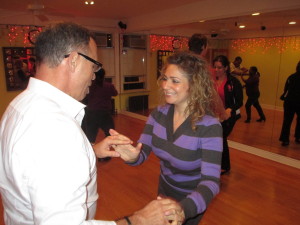
Bachata Class in Brooklyn, NY
Most bachata songs have a pretty clear beat that beginner dance students are able to pick up. It’s not like salsa or Argentine tango, where beginner dancers struggle with the tempo. But many bachata songs have long introductions. Some may be too fast for the beginner bachata student; and some may have too many breaks and pauses where the base totally drops out.
Take a song like Te Extrano by Xtreme. A great bachata, but I usually don’t play for a beginner bachata lesson because of the long intro. It’s more effective for teaching to play a song like Mi Receta De Amore by Los Toros Band. This may be one of the slowest bachatas out there. But, it’s great for beginners who almost always rush the timing. This song will slow them down. They will learn how to move the right way for bachata, and not worry about keeping up with a fast paced song.
Here’s a list of bachata music best for the beginner bachata student and beginner bachata classes. They are all slow to moderate tempo, with a steady base. These are some of the songs that I play when giving a private bachata lesson or during my beginner group bachata classes. Once the students are more comfortable dancing bachata, I will play songs with lots of accents, breaks and long introductions.
Slow to Moderate Bachta’s With a Steady Tempo: Pasion Monchy and Alexandra, Dos Locos Monchy and Alexandra, Cuando Volveras Aventura, Voy a Dejarte de Amar Frank Reyes, Tu Eres Ajena Frank Reyes, Me Voy Hector Acosta, Corazon Sin Cara Prince Royce, El Amore que Perdimos Prince Royce, Rechazame Prince Royce, Sin Ti Grupo Extra, Su Hombre Soy Yo Prince Royce
Bachatas With Long Intros: Te Extrano Xtreme, Casi Casi Toby Love, Llorar lloviendo Toby Love, Pomise Romeo Santos, Obsesion Aventura, Su Veneno Aventura, Incondecional by Prince Royce.
